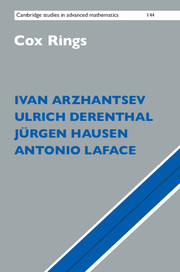6 - Arithmetic applications
Published online by Cambridge University Press: 05 October 2014
Summary
In Section 6.1, we give an overview of the theory of universal torsors over arbitrary fields of characteristic zero. Furthermore, we explore their connection to characteristic spaces and Cox rings. Section 6.2 deals with the existence of rational points over number fields. We discuss the Hasse principle and weak approximation. The failure of these principles is often explained by Brauer–Manin obstructions. We indicate how this can be approached via universal torsors and give an overview of the existing results. Section 6.3 is devoted to the distribution of rational points on varieties over number fields. Here, one introduces height functions on the set of rational points and is interested mainly in the asymptotic behavior of the number of rational points of bounded height. For Fano varieties, this behavior is predicted by Manin's conjecture. We indicate how universal torsors and Cox rings can be applied to prove Manin's conjucture. In Section 6.4, we specialize to del Pezzo surfaces. Here, Manin's conjecture is known in many cases, and a general strategy emerges. We discuss this strategy and some technical ingredients in detail. In Section 6.5, we show how it can be applied to prove Manin's conjecture for a singular cubic surface.
Universal torsors and Cox rings
Quasitori and principal homogeneous spaces
Here we summarize the basic concepts and facts on quasitori and their principal homogeneous spaces over nonclosed fields. The main references are [303, 304]. As an introduction to varieties over nonclosed fields and their rational points, we mention [253]. First we fix the setting.
- Type
- Chapter
- Information
- Cox Rings , pp. 437 - 500Publisher: Cambridge University PressPrint publication year: 2014
- 1
- Cited by



